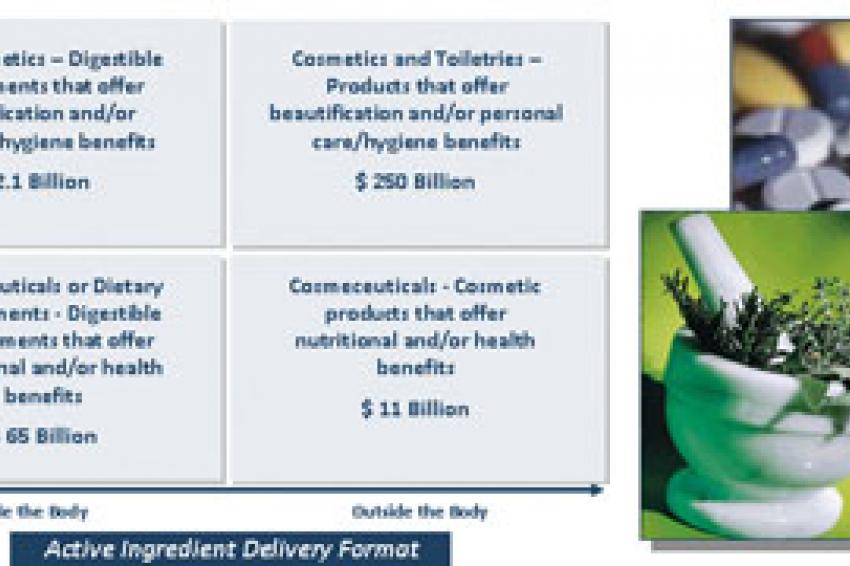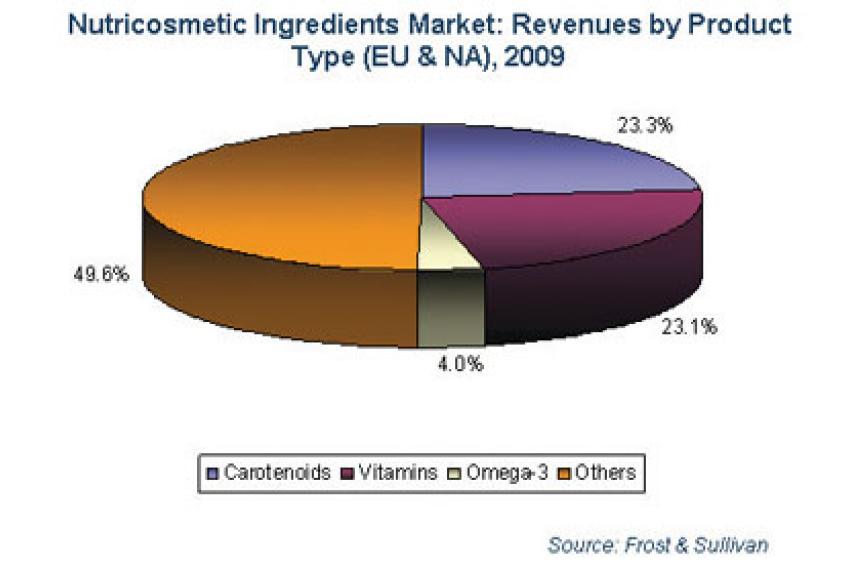Not Just Skin Deep
The Nutricosmetic Market Is Gaining Importance
Beauty From Within - The utilization of food ingredients as cosmetic products is not a new idea. This approach to beauty dates back to the ancient Egyptians and Greeks. Nutricosmetics is based upon the theory that the key to a beautiful face is a healthy body and was reborn as an idea in the 1980s. However it is since 2000 that the market has attracted a growing interest expressed in research and development, marketing activities and brand exposure. In the future the "beauty and wellbeing from within" trend is expected to further promote the integration of the food and cosmetics industries and the companies active in them.
Personal care and cosmetics have fared better than other markets, such as automotive and construction, during the economic recession. Nutricosmetics is one of the three hybrid markets under the umbrella of personal care and cosmetics. These products are taken orally, either as pills or liquids and have active ingredients that offer a vital link between health and cosmetic properties. When ingested, the products have an effect, preventive or reactive, on skin, nails and hair.
The total market for nutricosmetics in 2009 was valued at $2.10 billion and is expected to grow to $5.62 billion by 2015, with a compound annual growth rate (CAGR) of 17.8%. The nutricosmetics market could very well realize its potential if it harnesses the opportunities in the baby boomer group. The aging population could be persuaded to switch from cosmetics to nutricosmetics, if manufacturers provide them with scientific data about the properties of their products.
Market Challenges Amidst the Current Economic Contraction
The economic recession that started in the middle of 2008 is not the only market challenge. The massive growth potential of the North American market (NA) has not been unlocked yet. At present, the NA nutricosmetics market represents only 5% of the global market following from far behind, in third position, Japan and Europe.
The education of consumers is of paramount importance in order to achieve and sustain success in the nutricosmetics market and represents a major challenge for companies. The NA customers are not convinced yet. However, the scientific evidence alone is not enough to ensure success. The effective communication of product benefits to clients and consumers is necessary. An example of an ingredient manufacturer that has been successful in this area includes Kemin Industries with its FloraGLO lutein program. In general, until now the onus was not on the ingredient manufacturers to market the product to the consumer and create awareness, but on the formulator or the marketer of the finished product.
The Reach legislative framework, which came into power in June 2007 with the aim to change the responsibility from public authorities to industry in demonstrating the safe manufacture and use of chemicals, was met with mixed reactions. Part of the industry believes that Reach could result in stifled innovation and render the European chemicals industry non-competitive against its American counterpart. This can also have a tangible impact on the personal care and nutricosmetics industries.
Key Nutricosmetic Ingredients
Nutricosmetic ingredients are the ingredients which are used in the formulation of nutricosmetics. In 2009, the NA and European Union (EU) nutricosmetic ingredients market was valued at $228.7 million. The market is expected to grow to $528 million by 2015 with a CAGR of approximately 15% driven by specific market and social trends.
The largest nutricosmetic ingredients market segment, representing 49.6% market share, comprises numerous different nutricosmetic ingredients such as fruit extracts, green tea extracts, CoQ10, phytosterols, aloe vera and collagen. Because these ingredients individually account for very small market shares they are grouped together in the market analysis as a segment called "Others". The second largest segment is the carotenoids with 23.3% market share including beta-carotene, lutein and lycopene. Vitamins A, C and E hold the third largest market share representing 23.1% of the market. Vitamin A palmitate and vitamin A acetate (retinyl acetate) are the principal forms used as nutritional supplements. The smallest market share is occupied by poly unsaturated fatty acids (PUFA) and specifically Omega-3 representing 4% of the nutricosmetic ingredients in EU and NA.
Market Drivers and Restraints - It's All About the Consumer
The most important market driver is the "beauty and wellbeing from within" trend. The aging population globally is expected to play a catalytic role in the growth of the nutricosmetics market in the future. The changing demographic profiles of Europe and NA indicate that there is a rapid increase in the number of aging people. In 2005 in Western European countries, the median age ranged from 34-43 years while in US the median age was below 40. Over the next few years, a large number of European countries are expected to have the world's highest populations of people aged 50 and above. This age group has various health concerns, driven partly by the rising costs of healthcare, and also by concerns about the quality of life. Cosmetic and personal care products that offer anti-aging properties are expected to continue exhibiting a healthy growth. Nutricosmetic products will also benefit from this demographic change.
The most important restraint is the doubt that consumers have regarding the efficacy of nutricosmetic products. It is clear that the nutricosmetics industry need to do more to address successfully the questions posed and reassure consumers about the tangible benefits of these products. This can only be achieved by the active participation of the nutricosmetic ingredients manufacturers.
A Dynamic Market Competitive Environment
The competitive structure of the nutricosmetic ingredients market can be split into four tiers comprising major specialty chemicals companies, multinational chemicals companies, independent chemicals manufacturers, and food ingredient companies. The NA and European market for nutricosmetic ingredients is a growing market with more than 50 active companies in the market that manufacture and distribute nutricosmetic ingredients.
The number of new entrants is increasing, especially from China, where competition is based on the lower cost basis. Chinese companies are increasingly looking into expanding their operations in the global markets outside China and stop being solely exporters. However, there are still concerns regarding quality control issues and compliance to legislation.
Conclusion
The consumer represents the strongest driver, but at the same time the strongest restraint for the nutricosmetics market. "Beauty and wellbeing from within" is what consumers are looking for, even amidst the current challenging economic environment, but they are also ready to challenge the effectiveness of the marketed products. As the consumers become better informed, the formulators and ingredients manufacturers cannot continue to depend solely on marketing campaigns. Consumer education and effective communication based on scientific evidence is of paramount importance in order to achieve and sustain success in the nutricosmetics market.
Contact
Frost & Sullivan
Clemensstr. 9
60487 Frankfurt
Germany
+49 69 7703343
+49 69 234566








